Italian Cheese N-Z
The Last Eight Italian Cheeses
to Round Out the Top 14
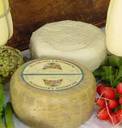
Parmigiano-Reggiano
Parmigiano-Reggiano should be the first cheese on this page, but it is so divine, sublime and an Italian Masterpiece in its own right... that it has its own page.
Pecorino Sardo

Also called Fiore Sardo, You can find Pecorino cheeses all over Italy; the word comes from the Italian "Pecora", meaning sheep ... and "ino", meaning little. However sheep's milk cheeses are more prevalent in central and southern Italy. D.O.P. Pecorino Sardo comes from Sardinia, an island off the west coast of Italy which is also known for its production of Pecorino Romano. In fact the aged versions of Pecorino Sardo and Pecorino Romano are quite similar in taste and texture, although Romano is more salty and sharper. Pecorino Sardo is relatively new on the Italian cheese scene where many cheeses can date back millenia! It was first produced in the late 1800s. Raw sheep's milk is used to form the 2-9 lb. wheels. There are both artisan and factory versions available and as I have often said, if you can buy an artisan version of any cheese, you should select it over a factory-produced version.

The cheese is made into small discs about 4 lbs. in weight and 4-5 inches in diameter. The thin rind is beige-colored, although more aged versions will have a much darker rind due to the fact that the cheese is regularly rubbed with olive oil during aging. The interior ranges from white to pale yellow with a scattering of eyes. The aged versions (4 to 12 months) become quite hard and granular, but the young versions (3-8 weeks) are soft and elastic. Delicate and sweet to the taste when young, you will find the older versions quite complex and even butterscotch-like. The young (dolce) Pecorino Sardo is sold with a green label and the aged version (maturo) is sold with a blue label. Both labels will show the D.O.P. mark and the logo of the Consortium which oversees its production. Sardo is not as widely available as Pecorino Toscano (see next paragraph), but if you can find it, you are sure to love it, both on its own and for its versatility in cooking.
Pecorino Toscano
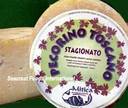
You can find pecorinos in every village throughout central and southern Italy; you simply cannot go wrong with whichever pecorino you may be offered. Most pecorinos are somewhat oily, due to the fact that sheep's milk is high in butterfat content. D.O.P. Pecorino Toscano is from the Tuscany region, made in dairies and small cheese factories. In the pantheon of Italian cheese, this one is near the top. The sheep's milk can be raw or pasteurized and aging typically lasts from just one month up to a year. Some versions are even older and very crumbly and dry and delightful. (Stagionato - aged, seasoned, mature) You might be interested to learn that the rind can be rubbed during aging with various substances - including tomato paste and olive oil!
The paste of the aged version is hard and suitable for grating, but also delightful to simply eat out of hand. Many think Pecorino Toscano is the best of all the pecorinos, but I leave it to you to judge for yourself. A good idea for a cheese tasting platter would be to include slices of several different pecorinos: Toscano, Sardo, Romano, Siciliano - including the young and aged versions of each and see how they differ. Which do you prefer?
Young Pecorino Toscano will taste quite different from its aged counterpart and its texture will be very different. Look for semi-soft paste which is elastic and pale in color. Tangy and mild in flavor, it pairs well with white wine. The aged Toscano will be rough in texture, with a sharp, sheepy flavor that can taste of olives. Very rustic, very simple - good to pair with an inexpensive, robust red wine like a Chianti or Brunello.
Piave
Many people have not heard of D.O.P. Piave, so the simplest quick description would be to say that it is a young version of Parmigiano-Reggiano. Made from pasteurized cow's milk in the region of Veneto, Piave will surprise you with its flavor - full, complex and sweet, but milder than Parmigiano; its texture - not as dry as Parmigiano, not as crumbly, but still showing signs of crystallization.
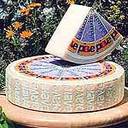
It's a lovely cheese, made from the milk of the Swiss Brown cow breed. Two milkings are used and then the cheese is aged to produce different styles or versions: fresco (20-60 days), mezzano (60-180 days), vecchio (more than 180 days) and stravecchio (more than one year). It's made in flat wheels ranging from 11 to 15 lbs.. The rind is yellowish and the interior is pale yellow. I prefer the older version with the fully developed flavor and the dry, crunchy texture.
Start Your Gourmet Cheese Investigation Today
...
 |
Includes:
|
Click on the image above to order a sampler. Enjoy some fine Gourmet Cheeses today! -- G.C.D.
Ragusano
D.O.P. Ragusano is unmistakeable due to its unique shape - a rectangular block or brick with the imprint of the name pressed into the side. Made from whole, raw cow's milk, Ragusano is one of the oldest cheeses made in Sicily, dating back to the 14th century.
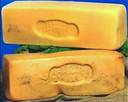
It was a key component of Sicilian trade throughout the Mediterranean centuries ago. It's a pasta filata cheese - cooked, stretched into its shape and brined. The 26-35 lb. blocks are hung from rafters while aging from 4- 6 months (for young versions) to one year or more (for aged versions). During aging, the rind is rubbed with a mixture of olive oil and vinegar, causing it to develop a deep, dark yellow color. Inside the paste is elastic in texture, with the flavor quite sweet and light and smooth when young, changing to a more piquant, fuller flavor with a granular texture as it matures. Ragusano is a rustic, provolone-style cheese which clearly reflects its Sicilian terroir (mostly mountainous or hilly, with lush meadows of grasses, herbs and flowers). Most of it is made in small dairies or on individual farms by hand. A true artisanal cheese steeped in Sicilian history and tradition - well worth a place at your table.
Ricotta Salata
Made from leftover sheep's milk curd from Pecorino Romano, Ricotta Salata is a pure white, firm, rindless ricotta cheese which originated in the dry climate of Sicily. Ricotta means re-cooked and the process of making Ricotta Salata simply uses the whey which is the byproduct from making Pecorino Romano.
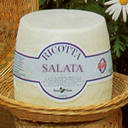
Today it is produced in Sicily, Sardinia and on the Italian mainland. The cheese is pressed, salted, dried and aged for at least three months. Sometimes compared to Feta, Ricotta Salata is a versatile cheese with a nutty, sweet flavor and a really smooth texture - there is no taste of sheepiness. Although the word Salata means salty, you won't find this cheese to be overly salty at all. Typically formed into 6 lb. plastic-wrapped wheels, there are two good brands to look for: Mannoni and Pinna- but really, all brands are quite good and you won't be disappointed. If you want a Ricotta Salata which can be grated, then look for an aged Sicilian version which are specially made for that purpose.
Robiola di Roccaverano
The name Robiola represents a large variety of Italian cheese made throughout northern Italy. The styles vary greatly but all robiola cheeses are small and soft. Cheesemakers scoop the curd into molds and let them drain naturally without pressing. Aging periods can be very short - 3 to eight days, or three weeks which is fairly typical - or, up to 3 months. You can find robiolas at the cheese shop which have been dressed up, wrapped in pine boughs, rosemary, cabbage, fig, grape or walnut leaves.
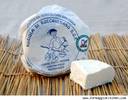
I have selected D.O.P. Robiola di Roccaverano as a top 14 Italian cheese. It's the only one of all the robiolas to be awarded that coveted designation, which in and of itself, tells you something. It has been made in the Piedmont region of northern Italy for at least 2,000 years. Named after the town of Roccaverano, this cheese must be made from the milk of animals fed only grass or hay. Traditionally made from raw goat's milk, today it is more likely to be made with mostly cow's milk (85% cow's milk is allowed by regulations), with some goat's or sheep's milk added in. Some versions are still made with 100% raw goat's milk, but these are hard to find, at least in the USA.
This is a great Farmstead or Cooperative cheese made in 9 to 14 oz wheels. The natural rind is very thin, off-white in color. There can be tinges of red or brown on the rind (hence the name Robiola which comes from the Latin word rubium meaning red). The interior is snowy white to ivory in shade. Young versions will be very creamy and delicate, with a nutty, sweet flavor. When allowed to come to room temperature prior to serving, Robiola di Roccaverano will begin to melt and ooze in an enticing way - just begging to be scooped up and eaten. The older versions are more coarse in texture with a pungent flavor. These cheeses are ideal as dessert cheeses, which stand well on their own without being added to a cheese platter of selections. Guffanti and Cora are excellent names to look for when purchasing Robiola di Roccoverano.
Taleggio
D.O.P. Taleggio is similar to Époisses de Bourgogne and Reblochon in texture, aroma and flavor. It is made in the province of Lombardy and dates back to at least the 10th century. A washed-rind cow's milk cheese, Taleggio may be dry-salted, but normally it is washed in brine after it is formed into square slabs weighing 3 3/4 to 4 3/4 lbs and measuring about 8 inches square (like a brownie pan).
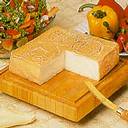
The rind is soft and pinkish to brownish in color and usually speckled with mold. (This is true for the artisanal Taleggios made from raw milk; the factory produced Taleggios will be even in color and spotless with no mold at all.) As it ripens the cheese starts to flatten out because the interior paste will begin to ooze at room temperature. The paste is pale yellow with just a sprinkling of eyes. The aging period is short - usually 25 to 50 days and you will find the cheese marked with the logo of the Consorzio di Tutela Formaggio Taleggio. You'll see 4 circles arranged in a square, with a capital T in 3 of the circles and the ID number of the manufacturer in the 4th circle. This is one of the top so-called Stinky Cheeses - typical description of a washed-rind cheese. Yes, the aroma will be strong and pungent, but the flavor will be soft, buttery and mild. Some good makers to look for are: Guffanti, Defendi and Caravaggio.
Don't miss my suggestions about Pairing Italian Cheeses with Wine. Cheese and wine go together like good friends and happy memories. If you are buying some Italian Cheeses, you need to buy a few bottles of wine at the same time.
Go to Parmigiano-Reggiano Cheese
Go to Italian Cheese A - M
HOME › Italian Cheese › Italian Cheeses N-Z

Looking for something specific on GourmetCheeseDetective.com?
Enter your request below:
Follow The Gourmet Cheese Detective on Twitter: @The_Cheese_Tec
Make Your Investigation of Gourmet Cheeses a Memorable One With Our Gourmet Cheese Detective's Notebook:

As any good Detective knows, keeping a record of your investigations is a must! Use this concise caseophile's pocket notebook to keep track of your Gourmet Cheese discoveries. Record your favorite cheeses, keep memos of your travels in the world of Gourmet Cheese, and compare notes with the other Gourmet Cheese Detectives you meet! Click on the image above to order your Gourmet Cheese Detective Notebooks now! - G.C.D.
Wish You Could Live Like Real World Travelers?

Dreaming of traveling the world enjoying Gourmet Cheeses in their native environs? Go on a global adventure from Irish Georgian mansions to windswept
coasts of Portugal, from Turkish bazaars to the contact sport of
Italian grocery shopping with Lynne and Tim Martin’s book, Home Sweet Anywhere. It is
a road map for anyone who dreams of turning the idea of life abroad into a
reality. Click the image above to order your copy today and begin your own explorations! - G.C.D.